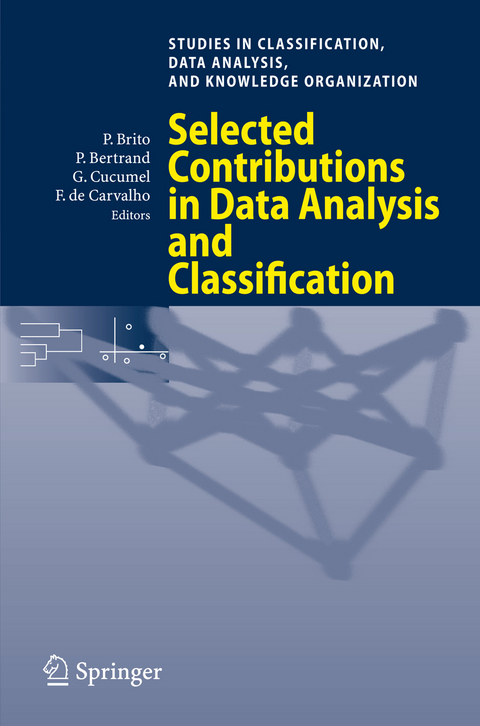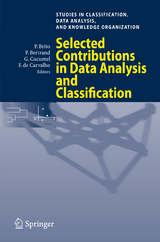Selected Contributions in Data Analysis and Classification
Springer Berlin (Verlag)
978-3-540-73558-8 (ISBN)
Analysis of Symbolic Data.- Dependencies and Variation Components of Symbolic Interval-Valued Data.- On the Analysis of Symbolic Data.- Symbolic Analysis to Learn Evolving CyberTraffic.- A Clustering Algorithm for Symbolic Interval Data Based on a Single Adaptive Hausdorff Distance.- An Agglomerative Hierarchical Clustering Algorithm for Improving Symbolic Object Retrieval.- 3WaySym-Scal: Three-Way Symbolic Multidimensional Scaling.- Clustering and Validation of Interval Data.- Building Symbolic Objects from Data Streams.- Feature Clustering Method to Detect Monotonic Chain Structures in Symbolic Data.- Symbolic Markov Chains.- Quality Issues in Symbolic Data Analysis.- Dynamic Clustering of Histogram Data: Using the Right Metric.- Clustering Methods.- Beyond the Pyramids: Rigid Clustering Systems.- Indirect Blockmodeling of 3-Way Networks.- Clustering Methods: A History of k-Means Algorithms.- Overlapping Clustering in a Graph Using k-Means and Application to Protein Interactions Networks.- Species Clustering via Classical and Interval Data Representation.- Looking for High Density Zones in a Graph.- Block Bernoulli Parsimonious Clustering Models.- Cluster Analysis Based on Posets.- Hybrid k-Means: Combining Regression-Wise and Centroid-Based Criteria for QSAR.- Partitioning by Particle Swarm Optimization.- Conceptual Analysis of Data.- Concepts of a Discrete Random Variable.- Mining Description Logics Concepts with Relational Concept Analysis.- Representation of Concept Description by Multivalued Taxonomic Preordonance Variables.- Recent Advances in Conceptual Clustering: CLUSTER3.- Symbolic Dynamics in Text: Application to Automated Construction of Concept Hierarchies.- Consensus Methods.- Average Consensus and Infinite Norm Consensus : Two Methods for Ultrametric Trees.- Consensus from Frequent Groupings.- Consensus of Star Tree Hypergraphs.- Data Analysis, Data Mining, and KDD.- Knowledge Management in Environmental Sciences with : Application to Systematics of Corals of the Mascarene Archipelago.- Unsupervised Learning Informational Limit in Case of Sparsely Described Examples.- Data Analysis and Operations Research.- Reduction of Redundant Rules in Statistical Implicative Analysis.- Mining Personal Banking Data to Detect Fraud.- Finding Rules in Data.- Mining Biological Data Using Pyramids.- Association Rules for Categorical and Tree Data.- Induction Graphs for Data Mining.- Dissimilarities: Structures and Indices.- Clustering of Molecules: Influence of the Similarity Measures.- Group Average Representations in Euclidean Distance Cones.- On Lower-Maximal Paired-Ultrametrics.- A Note on Three-Way Dissimilarities and Their Relationship with Two-Way Dissimilarities.- One-to-One Correspondence Between Indexed Cluster Structures and Weakly Indexed Closed Cluster Structures.- Adaptive Dissimilarity Index for Gene Expression Profiles Classification.- Lower (Anti-)Robinson Rank Representations for Symmetric Proximity Matrices.- Density-Based Distances: a New Approach for Evaluating Proximities Between Objects. Applications in Clustering and Discriminant Analysis.- Robinson Cubes.- Multivariate Statistics.- Relative and Absolute Contributions to Aid Strata Interpretation.- Classification and Generalized Principal Component Analysis.- Locally Linear Regression and the Calibration Problem for Micro-Array Analysis.- Sanskrit Manuscript Comparison for Critical Edition and Classification.- Divided Switzerland.- Prediction with Confidence.- Which Bootstrap for Principal Axes Methods?.- PCR and PLS for Clusterwise Regression on FunctionalData.- A New Method for Ranking n Statistical Units.- About Relational Correlations.- Dynamic Features Extraction in Soybean Futures Market of China.
| Erscheint lt. Verlag | 27.8.2007 |
|---|---|
| Reihe/Serie | Studies in Classification, Data Analysis, and Knowledge Organization |
| Zusatzinfo | XIII, 635 p. |
| Verlagsort | Berlin |
| Sprache | englisch |
| Maße | 155 x 235 mm |
| Gewicht | 985 g |
| Themenwelt | Mathematik / Informatik ► Mathematik ► Wahrscheinlichkeit / Kombinatorik |
| Schlagworte | algorithms • classification • cluster analysis • Clustering • Data Analysis • Data Mining • Datenanalyse • Dissimilarity Analysis • Hardcover, Softcover / Mathematik/Wahrscheinlichkeitstheorie, Stochastik, Mathem • HC/Mathematik/Wahrscheinlichkeitstheorie, Stochastik, Mathematische Statistik • Klassifikation • Knowledge Discovery • knowledge management • learning • Multivariate Statistics • Operations Research • Optimization • Principal Component Analysis • Random Variable • Statistics |
| ISBN-10 | 3-540-73558-5 / 3540735585 |
| ISBN-13 | 978-3-540-73558-8 / 9783540735588 |
| Zustand | Neuware |
| Haben Sie eine Frage zum Produkt? |
aus dem Bereich




